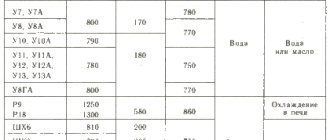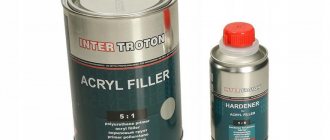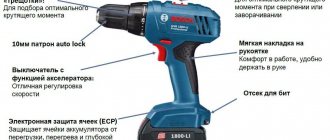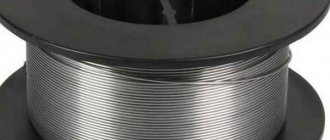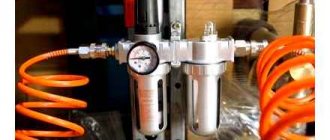From compressed air | 08/26/2016
When working with any pneumatic equipment, it is necessary to ensure that purified air, which is enriched with oil particles, is supplied to the system. A filter copes with the first task, but for the second, a lubricator for pneumatic tools is needed. With this device, the air flow is diluted with oil during the spraying process, and this greatly extends the service life of all equipment and reduces wear rates. This is especially important for those who are forced to regularly resort to the use of pneumatic devices (workshop employees, service stations, construction crews, etc.).
Modern lubricators have an autonomous design; their system allows you to calibrate the supply of lubricants during operation; thus, the pneumatic tool receives the required amount of fluid. During operation, you can control the oil level in the refill container. During operation, it is important to use the types of consumables recommended by the manufacturer: the use of low-quality or simply unsuitable oil leads to malfunctions not only of the equipment, but also of the lubricator itself.
How to add oil
Before adding lubricant, you must disconnect the tool from the line and make sure that there is no residual pressure in its working parts. To do this, press the power button several times and allow the air to escape from the tool. Next, you need to open the lid and carefully, using a funnel, add lubricant from a small container. It is strictly not recommended to add silt from large canisters; spilling some of the oil and subsequent cleanup is almost inevitable. Many equipment and lubricant manufacturers include special measuring vessels with a spout in the delivery package. They are made of transparent plastic and allow you to measure the required amount at one time and carefully and without loss pour it into the container.
Sometimes novice users ask questions: is it possible to lubricate pneumatic tools without a portable lubricator? The answer is simple: only if a stationary lubricator is used.
Doctors' recommendations
The first thing you should trust is the recommendations of doctors. Choose a product that is guaranteed not to cause irritation or side effects.
Austrian pharmaceutical lubricant is a hypoallergenic gel with a neutral environment, close to a woman’s natural lubrication. Does not cause discomfort or irritation when applied, compatible with latex and condoms.
Analyzing user reviews about lubricants, we can conclude that Montavit gel is suitable for everyone, because it is transparent, odorless, does not leave marks on clothes and is easily washed off.
Criterias of choice
Greases: properties and classification
When choosing a device, you must be guided, first of all, by what work the equipment is required for and what its volume is. The purchase of equipment must, among other things, also be economically justified.
The following parameters are key:
- Lubricator throughput. It must be no less than the operating flow rate of the connected consumer. It is better to provide a 10-20% reserve for peak loads. Using a device with a lower capacity will lead to a decrease in the consumer’s operating efficiency and deterioration of lubrication conditions.
- Operating pressure. Of course, you cannot install a device designed for less pressure than the load consumes. Such a vessel will simply fail. Too large a pressure reserve will not improve the operating conditions of the equipment, but will lead to an unjustified increase in the cost of the planned purchase.
- Materials used. It is better to choose metal vessels, especially those designed for high pressure. And not just any Chinese ones, but only high-quality alloys produced by global brands. The consequences of a hull rupture will be significantly more expensive.
- Connecting dimensions. The dimensions and type of thread must be suitable for the user. The use of adapters in this case is highly undesirable. Many manufacturers directly indicate the inadmissibility of this approach
If you do not have sufficient skills in handling pneumatic tools and organizing air lines, it is better to engage an experienced expert for consultation.
It is imperative to install a water vapor separator BEFORE the lubricator or distribution unit. Moisture entering the device will significantly reduce its performance. The quality of lubrication of pneumatic tools and its performance will also decrease. Prolonged operation in this mode will lead to breakdown and costly repairs.
During work, you should systematically check the oil level in the reservoir and replenish it in a timely manner. It is better to do this before starting work, so that you do not have to be interrupted in the middle of the working day.
Manual lubrication syringes
The SKF range includes manual and electric grease guns, hand and pneumatic grease pumps. They can be used not only to re-lubricate bearings, but also to lubricate other lubrication devices.
Grease guns TLGH, 1077600 Used with cartridges or free grease. Stroke volume TLGH - 0.9 cm3, 1077600 - 1.5 cm3.
One-handed grease gun LAGH Refillable with pumps or a special device, or can be used with a cartridge. Easy to use.
Syringe for LAGP cartridges Set with three tips.
Cordless grease gun TLGB Built-in flow meter. The battery charge level is shown on the display. Maximum operating pressure: 400 bar. The battery charge is enough for 15 standard 0.4 kg cartridges.
Advantages of a mini-lubricator
Features of the use of lubricant "cyatim 221". analogues
The use of an oil sprayer is a prerequisite for the operation of pneumatic tools. Manufacturers in the user manual must indicate a list of recommended and compatible brands of lubricants.
The use of devices has the following advantages:
Automation of lubricant supply to pneumatic equipment. This saves working time spent on equipment maintenance. You just need to monitor the level of lubricant in the container. A high-quality oil-air mixture significantly reduces wear on the moving parts of pneumatic tools and increases its performance. In addition, the service life of equipment is significantly extended and non-productive costs for its repair are reduced. Reduced resource losses that occur during breakdowns and production stops
This is especially important for enterprises operating in continuous cycle conditions. Current designs of mini-lubricators are very compact and do not create interference or inconvenience when working with the tool throughout the entire shift. Multipoint devices allow simultaneous supply of up to 8 different consumers. For each, an individual mode of saturating the mixture with lubricant can be set.
Old models had a drawback - large weight and dimensions, which interfered with the worker’s movements and caused increased fatigue during prolonged work.
What kind of oil to fill
Engine lubrication system: purpose, design, troubleshooting
Sometimes when purchasing lubricant lubricant there is a temptation to save money. Purchasing cheap oils of obscure origin from little-known manufacturers seems like savings only at first glance. Such a replacement will inevitably lead to disruptions in the operation of the oil evaporator, uneven saturation of the air flow with lubricant, deterioration of the lubrication conditions of the pneumatic tool, a decrease in its service life and failure.
You need to use exactly the oil that is recommended in the instructions for the tool, or oil from the list of analogues approved by the manufacturer for use.
Separately, it is necessary to ensure the cleanliness of the lubricant, the absence of chemical contaminants and mechanical inclusions. Such “additives” will damage the tool even faster.
Principle of operation
This device is a container made of a metal alloy, which is placed at the inlet of the pneumatic tool and fixed with a thread. The device is installed immediately after the drying filter. After the air mass enters the device, it is saturated with oil and sent directly to the instrument.
The length of the hose between the device and the lubricator should not exceed 10-12 meters, otherwise the oil will be distributed ineffectively, and condensation will form on the walls, which adversely affects the efficiency of the application. In a situation where this hose length is not quite enough, you can use linear devices installed in front of the equipment.
These devices also differ in the volume of the storage vessel, the material of production and the thread. In addition, devices are multi-point and single-point, and their selection is made taking into account the conditions of future use. In addition, according to the type of design of the device, there are two varieties:
- filter devices that are installed directly on the tool;
- air devices that are installed on a flow distributor or compressor.
Varieties
Lubricators offered for pneumatic tools can be classified into several categories
First of all, by design:
- portable, attached to the inlet of pneumatic tools;
- stationary, installed near the compressor or distribution center.
Based on tank volume:
- portable up to 100 ml;
- average from 100 to 500 ml;
- large over 500 ml.
According to the material from which the tank and mixing chamber are made:
- metal;
- oil and petrol resistant plastic;
- mixed designs.
By connecting size, inches.
There is special equipment for large production complexes for large thread sizes. There are also devices with external and internal threads. It is necessary to pay attention to these nuances when configuring the equipment.
How to add oil?
Oil is poured into the stationary one using a funnel through a hole located on the upper plane of the equipment. As a rule, the hole is closed with a plug for an internal hexagon. If there is no special hole provided, then oil is poured into the removed flask and then installed back.
Oil is poured into the small one through a hole on the body, which is unscrewed with either a Phillips or flat-head screwdriver. The oil is added using a small plastic oil can. In order to control the oil level in the tank, there are two marks on its body - the maximum and minimum volume levels.
Advantages of lubricators
The use of such mechanisms is a mandatory requirement for the rational and efficient operation of pneumatic tools. The use of lubricators has many advantages:
- Lubricant in the form of oil is supplied to the structure automatically, which significantly reduces the cost of effort and time for servicing the tool.
- Oil supply significantly reduces wear rates: lubricants reduce friction of key equipment elements and make productivity much higher.
- A lubricator for pneumatic tools can significantly reduce the risk of unplanned downtime that can occur due to equipment breakdown.
- Modern devices are compact and can be installed in the most inaccessible places, while the installation angle also varies.
- The use of multi-point lubricators makes it possible to lubricate up to 8 points simultaneously.
Automatic lubrication
Lubricators are used for single-point or multi-point lubrication. Compared to manual lubrication, such a device is able to provide a more accurate and dosed supply of grease or oil lubricant contained in it.
Single-point lubricators with gas drive LAGD Operating time from a month to a year. The compact size allows you to install lubricators in hard-to-reach places. ATEX for zone 0.
Single Point Lubricators with Electromechanical Drive TLSD Simple lubricators suitable for environments with temperature variations. Pressure up to 5 bar.
Single-point lubricators with electromechanical drive TLMR Thanks to pressures up to 30 bar, they can be installed away from lubrication points. Extended operating time up to 24 months.
Multi-point automatic lubricators TLMP Up to 18 lubrication points. Full set. Tank volume 1l.
What is a lubricator
This device allows the air flow to be diluted with oil when spraying, which minimizes wear and extends tool life. This is especially true for craftsmen who often use pneumatic equipment (service station employees, builders, workshop workers, etc.).
The models that are on sale today are characterized by an autonomous design. At the same time, the system allows you to regulate the supply of the oil mixture during operation; accordingly, the pneumatic tool will receive exactly the volume of liquid that it needs.
During operation, you can also adjust the oil in the filling container
Here it is important to use exactly the type of consumables recommended by the manufacturer: using an unsuitable or low-quality oil mixture can lead to failure of both this element and the equipment itself. Only if you have certain knowledge and skills can you repair the instrument yourself
In other cases, it is better to turn to professionals.
The editors of the site recommend that you familiarize yourself with the types of reducers for household gas cylinders.
Tool cost
The price of lubricators depends on a number of factors:
- material (brass, iron, steel, etc.);
- the volume of the lubricator vessel into which the oil mixture will be poured;
- installation method;
- the number of points that the device can process simultaneously;
- indicators of maximum pressure and throughput;
- manufacturer.
The most profitable solution is to purchase a lubricator on the Internet. But first you need to decide what you personally need a lubricator for.
Advantages of lubricators
After it has become clear what a lubricator for pneumatic tools is, you should understand the remaining nuances. The most important thing is the advantages:
Due to the fact that all actions carried out must meet certain requirements and conditions, additional installation of a lubricant is required. It will reduce equipment wear and increase its operation.
Lubricant enters the products automatically. This means that workers no longer need to waste their time pouring oil into the tool.
Minimize the risk of operational downtime, which is a very common cause of various types of breakdowns.
Most of the mechanisms produced are universal and compact. It is installed almost everywhere.
People will no longer have to wonder what caused the breakdown of oil equipment if a lubricator is installed.
Find out more about intimate gels, lubricants, lubricants
- Details about intimate lubricants: types, composition, purpose, application
- Gel, lubricant, lubricant..? How to distinguish and choose products for intimate pleasures?
- We buy lubricant for sex. Which one to choose?
- Water-based lubricants aren't just for sex.
- Silicone or water-based lubricants, which is better?
- The Best Water-Based Lubricants in 2022
- Are there absolutely hypoallergenic lubricants?
- Universal lubricants for sex
- We compare lubricants by price in pharmacies
- The world's best brands, manufacturers of intimate gels, feminine hygiene products and cosmetics
- Where to buy intimate lubricant: in a pharmacy, sex shop or supermarket?
- Lubricant for intimate use. Buy it at a pharmacy or sex shop?
- How to use lubricant correctly?
- Love without sex. What is missing..?
- Intimacy - advice from a sexologist.
- Intimate cosmetics. How to make sex enjoyable and varied?
- Instructions for use of intimate lubricant "Montavit gel"
- Consumer reviews, analogues of the Austrian invisible lubricant “Montavit Gel”
- Why do women need intimate gels?
- Gel lubricant for women is a must have!
- Women's problems. When is intimate lubricant needed?
- Intimate care for women: useful tips
- Common mistakes in feminine intimate care
- Cleanliness in the intimate area. What does a vagina need besides water?
- Intimate sphere: responsibility of a gynecologist, sexologist, psychologist
- What to do when menopause occurs?
- What lubricants help with menopause?
- Hygiene, health, quality of life. Austrian pharmacology.
- Intimate hygiene and sex: history, traditional and newest intimate lubricants
- Vaginal secretion: correct composition, disorders, recovery
- Inflammation of the vulva, genital infections
- Problems of the female genitourinary system
- Genital allergies: causes, symptoms, treatment
- Modern feminine intimate hygiene products. Doctors' opinion.
- Dryness in the intimate area - lack of natural lubrication
- Microcracks in the vaginal area: causes, how to cope?
- Itching and burning in the intimate area: causes, treatment, prevention
ALL ARTICLES
How and with what frequency should pneumatic tools be lubricated?
However, there is another way - to install a mini-lubricator or air preparation unit on the device. For pneumatic tools, it is recommended to use special oil with special additives, because any other industrial oils have a negative effect on the rubber parts of the tool.
In addition to oil sprayers, there are other systems for lubricating compressed air with oil mist. The oil mist thus obtained has a high degree of homogeneity with a particle size of 0.3-2 µm. This significantly reduces oil consumption and also supplies lubricated air to devices located at a distance of up to 500 m.
Mobil Almo oil is a highly purified mineral oil based on paraffin and contains emulsifiers, anti-wear, adhesive and anti-corrosion additives. The product is designed to protect against aging and corrosion in hammer drills and other pneumatic tools.
Mobil Almo air tool oil meets all tests and specifications designed for oils used in severe mining applications. It is approved by Ingersoll Rand Company, Joy Manufacturing Company and other companies.
We study the composition of lubricants
A modern, intelligent person who cares about his health is accustomed to thinking about the benefits and harms of everything he is about to consume. Naturally, it is useful to know what is included in modern lubricants, and which components in intimate lubricants should be avoided.
On the label of intimate lubricants you can find many different components, the presence of which in large quantities can have undesirable, even harmful effects on the body:
- Glycerin is the most common lubricating component of lubricants; in high concentrations it dehydrates and damages the mucous membrane;
- Menthol is a cooling component and can cause allergies. Added to lubricants with a prolonging effect;
- Benzocaine is a component that relieves itching and causes mild numbness, also a component of long-acting lubricants. Causes dermatitis;
- Synthetic fragrances are chemical components that most often cause irritation, and the phthalates included in the composition affect the reduction of reproductive function in men;
- Propylene glycol is a preservative that is potentially dangerous. Prohibited for use by many certification systems. Causes a severe allergic reaction;
- Sugar or sucrose - almost always added to flavored lubricants, creates an imbalance in the natural pH of the mucous membrane. In addition, it creates a favorable environment for the development of fungal infections;
- Red pepper extract - sometimes used as part of stimulating, warming intimate lubricants. May cause redness and even burns on sensitive skin in intimate areas;
- Parabens are xenoestrogens, synthetic preservatives with a cumulative effect. May cause allergies. In addition, there are studies suggesting their connection with the risk of cancer.
- Phenoxyethanol is a preservative and is classified as a moderately hazardous chemical. Has a cumulative effect. High levels of this substance can harm the reproductive system.
- Alcohol or chlorhexidine - has an antiseptic function, but can cause even greater dryness and irritation;
- Mineral oils are components that have increased tightness and disrupt the normal functioning of the skin;
These components perform very specific functions in the lubricant and can give a negative effect only in case of individual intolerance and severe sensitivity...
⇧
Design and principle of operation
The design of the microlubricator is very simple. This is a metal cylinder mounted on the inlet pipe of a pneumatic tool on a threaded connection. Inside there is an oil container and a mixing chamber. The lubricant enters the chamber from a container connected by a pipe. The air flow passing through the chamber picks up its droplets and mixes them into an oil-air mixture. Next, air enriched with lubricant enters the inlet pipe of the pneumatic tool, lubricating it.
The stationary lubricator is somewhat more complicated, but its operating principle is the same.
When designing air lines, one must take into account the limitation: the distance from the lubricator to the consumer should not exceed 8-10 m. Otherwise, the uniformity of mixing of the oil-air mixture will decrease, and droplets will begin to settle on the walls of the hose. The tool will not receive full lubricant. If longer hoses are required, it is better to install portable oil sprayers on the inlet pipes of air tools.
How the device works
To understand what a lubricator is and how this device works, you need to decide what this oil supply tank actually is. The body of the product is predominantly made of metal. This reservoir is “put on” the working area of the pneumatic tool, and then adjusted using nozzles with suitable threads.
The equipment itself must be installed after the air filter. Otherwise, nothing happens, or the filter will be damaged. If the additional devices are installed correctly, the supplied raw material will be enriched with air and later receive the required amount of oil. Next, the substance enters the hose itself.
In order not to reduce the quality of the operations performed, it is located at a distance of no more than 10 meters. Otherwise, the composition simply will not be supplied in the required quantity to the tool, which will certainly lead to a decrease in the quality of operations. In addition, it is necessary to ensure that no condensation remains in the hose.
However, there are situations when the hose length is simply not enough. In this case, it is best to purchase special-purpose equipment that is installed directly on the tool itself and increases productivity.
In order to understand what mechanism is needed for a certain type of work, it is better to immediately understand what characteristics must correspond to a particular product. The most common of these are:
Diameter of the mounted thread.
The materials from which the tanks were made.
Tank volume.
In addition, employees immediately determine what type of actions will be performed in the work shop. Based on this knowledge, the type of device used is already determined. It can be single-point or multi-point.
And in addition to this data, you should know what type of structure will be used during the work. A filter dispenser can be purchased. It has the property of being installed at the optimal distance between the hose and the handle.
Often workers do not know that such a lubricator is installed on the compressor. In rare cases, installation will be carried out directly on the air flow distribution mechanism.
Filter driers
The air in a factory or auto repair shop contains too much excess moisture, impurities and dust, which freely flow into the operating air compressor.
Impurities and moisture can be effectively separated using air filter dehumidifiers, which use fine-mesh copper alloy mesh as the filter element. Like any filter, it requires replacement during operation, which is indicated by a change in the color of the filter element.
To remove excess moisture from the filter, there is a tap at the bottom of the tank. Filter driers are connected at the beginning of the pneumatic line or directly at the tool.
Main differences:
- Inlet size
. Typically these are 1/4″, 3/8″ and 1/2″ and should match the hoses being used; - Degree of purification
. Higher levels of cleaning may be required for paint equipment to minimize excess paint contamination; - Availability of pressure gauge and pressure regulator
.
There are special fine filters for painting equipment. They have several cleaning elements installed, operating sequentially.
The Garage Tools store offers Licota filters for a wide variety of equipment and purposes.
Nailer care and lubrication
Like any professional pneumatic tool, the mounting gun is manufactured taking into account the high functional load. Since this equipment is quite reliable, then, in principle, all care consists of observing generally accepted measures and standards for operation and cleaning.
They are quite simple and consist of removing contaminants that periodically accumulate on working parts and careful handling. The tool must not be thrown. You need to make sure that no water gets into it. In short, mechanical deformation and damage must be avoided.
Everything said above can be attributed to any devices. As for the pneumatic nailer, it is also necessary to add that this type of tool needs to be lubricated. This is done according to the manufacturer's instructions. Most often, this procedure involves placing a few (2-3) drops of oil into the connecting fitting before starting work. This manipulation must be repeated in the middle of the working day if the tool is actively used.
If there is a long break in work, it is recommended to drop the same 3 drops into the nailer and take several shots to distribute the oil evenly. This will protect the inner surface from corrosion.
Vaginal dryness: where does it come from?i
Vaginal dryness can have various causes. As a rule, it is not a serious disorder, but only a transitional condition. If dryness persists for a long time, you should consult a doctor to find the source of the problem together. Among the causes of the phenomenon are:
- stress;
- fatigue;
- lack of desire for sex;
- hard training;
- oral contraceptives;
- some antibiotics and other drugs (such as antidepressants);
- lactation;
- phase of the menstrual cycle;
- menopause;
- chemotherapy
- cosmetics, such as soap, are not suitable for intimate hygiene).
So it is not true that a woman can always have sex.
What is a lubricator
A lubricator, or oil sprayer, is a device for creating a suspension of oil droplets in the compressed air supplied to drive pneumatic tools.
Not all compressed air consumers need to supply the oil-air mixture through a hose. It will render them unusable or interfere with normal functioning. For them, on the contrary, it is necessary to pass the air flow through an oil separator, which absorbs droplets of oil that enter it in the cylinders of a piston compressor. These are consumers such as:
- spray guns and other installations for spraying liquids and applying coatings to surfaces;
- sandblasting units;
- devices for inflating wheels and other containers;
- nozzles for cleaning surfaces and blowing out cavities of parts.
But for pneumatic impact wrenches, hammers, scissors, scrapers - all consumers containing moving parts and converting the energy of compressed air into mechanical energy of rotation or reciprocating motion.
Proper lubrication reduces friction between these moving parts, as well as their wear. The absence of the lubrication system’s own oil reservoir as such allows one to reduce the weight, dimensions and cost of pneumatic tools.
Today's pneumatic equipment market offers a large number of lubricator models, both stand-alone, mounted on a hose next to the consumer tool, and centralized, mounted on the wall next to the compressor or air line distribution unit. The devices allow you to control the degree of saturation of the oil-air mixture, selecting the optimal composition for each consumer.
During operation, it is important to monitor the level and quality of oil in the lubricator filling tank. The use of low-quality equipment that does not meet the manufacturer’s conditions or contaminated oil can accelerate the wear of the tool supplied from the station or even cause it to fail.
Repairing pneumatic tools, despite the apparent simplicity of its design, requires highly qualified specialists and special equipment. Self-repair without experience and equipment can permanently damage the instrument.
Buy a lubricator for pneumatic tools
You can place an order for a pneumatic lubricator in the following way:
- Place an order for an oil spray filter for pneumatic tools through the website. Afterwards, our store managers will contact you to agree on the details of the order, method of payment and receipt;
- Call toll-free 8-800-500-13-97 and place an order for a compressor lubricator;
- Write to an email or online chat consultant about positions you are interested in;
- Visit AIST retail stores in St. Petersburg and Moscow and buy a lubricator for lubricating pneumatic tools. Contacts contain all information on the location and operating hours of stores.
It is also possible to leave a request for a call back, which will be carried out at a time suitable for the client.
Orders are managed by professional employees of the AIST company, who are always ready to advise on the characteristics of lubricators for pneumatic tools, methods of payment and receipt of the order.
How to choose?
The next question is as simple as possible. If production management learned what a lubricator is, they will definitely want to purchase it for their employees. Because using it in production significantly reduces the cost of repairs and the purchase of additional materials.
First of all, you need to decide on the scope of purpose and the equipment used. When it is already clear what brand of pneumatic tool will be installed, it is best to understand how much power will be required. Products with minimum values will simply not meet the conditions. And mechanisms with high power can cause constant failures on weak equipment.
After this, the material required for the device is selected. It should not allow excess oil to pass through, and no condensate should remain in the hose.
Criterias of choice
Designs of this type must be selected based on the tasks and application features
You should pay attention to the following characteristics:
- Throughput: any lubricator must be matched to specific equipment. If the throughput indicator is not very large, then the use of equipment will be less effective.
- Operating pressure. This characteristic determines whether the device can cope with the load placed on it.
- Materials from which the body is made. The device must be made of high quality steel alloy: these devices are characterized by the highest reliability and durability.
- Thread size and location: if this parameter does not match, the lubricator will not fit your air tool.
If you have any doubts regarding your choice, it is better to consult with an experienced specialist. After purchasing a lubricator, you need to use only a specific oil mixture. You also need to prevent water from getting inside the device and check the oil from time to time.
Modular groups
Since proper air preparation is impossible without the simultaneous use of filter-driers and lubricators, when installing a pneumatic line it is logical to combine them in one housing with a single connection. Such a device is called a modular group or filter-lubricator and may additionally include an air pressure regulator and a pressure gauge.
Lubricator filters differ in the cross-section of the threaded connection, on which the throughput of the device directly depends. Therefore, for high-power pneumatic impact wrenches, it is worth choosing modular groups with threads of 3/8″ or more.
Operating principle of an oil sprayer (lubricator)
The oil sprayer (lubricator) must be supplied with air pre-cleaned from compressor oil and moisture. The figure shows the design of the oil sprayer. If air is supplied to the oil sprayer (lubricator), but there is no air consumption, then equal pressure is established in cavities A and B. The oil sprayer (lubricator) does not work and no oil is sprayed. With the advent of air flow in the oil sprayer, two air flows are formed. The main flow from the inlet, bending membrane 6, passes through the windows and goes directly to the outlet of the oil sprayer. The rest of the flow passes through hole 7, flows around nozzle 8 and, thanks to the suction action of the main flow, also enters the outlet. When flowing around nozzle 8, the auxiliary flow sucks air through it from cavity A, reducing the pressure in it. Under the influence of the higher pressure of cavity B (the pressure in this cavity is equal to the main one), oil from glass 1 rises through tube 9, passes through check valve 5 and from inlet 10 drops fall into the conical hole of nozzle 8. The frequency of drops falling when air flows through the oil sprayer is regulated throttle 4 installed on the communication line between cavities A and B. The frequency of drops falling is also affected by the air flow through the oil nozzle and the oil level in the glass. To reduce the influence of compressed air consumption on the intensity of falling oil droplets, a flexible membrane 6 is used, which automatically adjusts the flow area through the oil sprayer, thereby maintaining the required air flow rate in hole 7. When droplets fall from nozzle 8, the oil is initially sprayed, and the air is drops of oil are carried to the outlet of the oil atomizer, where they meet the main air flow, this leads to re-atomization of the oil, which makes it possible to obtain the smallest drops of oil suspended in the air. If there is no air flow through the oil sprayer, the pressure in cavities A and B is equalized, and the fall of oil drops from nozzle 10 stops. In this case, the ball check valve 5 prevents the oil level from decreasing in pipeline 9 (due to pressure equalization in cavities A and B), due to which the supply of oil for spraying begins immediately after air flow through the oil sprayer occurs.
